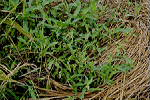
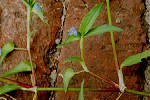
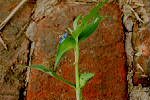
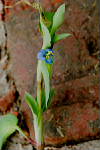
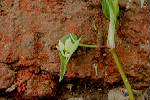
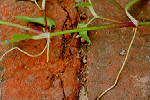
Botany Biology Phenology Ecology Distribution Cultural control Biological control Chemical control
| Description : | Terrestrial, annual or perennial, prostrate herb, up to 100 cm long, rooting at nodes. Roots fibrous, white or brown. Stem rounded, solid, glabrous, succulent. Stipules absent. Leaves simple, alternate spiral, sessile, lanceolate, elliptic, or ovate, glabrous on both sides, margins entire, succulent, apex acute, base clasping, parallel veined, leaf sheats present, rounded in cross section, hairy, ligules absent. Flowers bisexual, grouped in axillary or terminal inflorescences, covered by a spathe. The spathe edges are free in the base, long from 1 to 3,5cm, shortly pedunculated and hairless. Flowers single or few, stalked, blue, petals 3, free. Fruit a capsule, opening with 3 valves. |
| Seeds : | 5 seeds per capsule, reticulate-ribbed, elongated, brownish, long from 2 to 3mm. |
| Seedling : | First leaves elliptic, 2 to 3cm long and 1 to 2cm wide. Limb subsessile, hairless, with parallel nerves and the margin not wavy. |